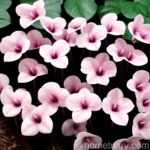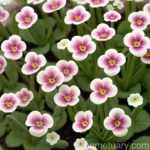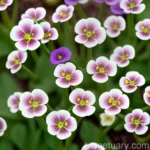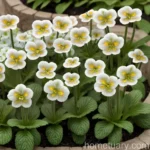Drumstick Primula: A Comprehensive Guide
Drumstick primula, scientifically known as Primula denticulata ‘Ronsdorf’, is a mesmerizing perennial plant that belongs to the primrose family. With its charming spherical clusters of flowers, this plant forms an eye-catching display in any garden. In this comprehensive guide, we will delve into the intricate details of drumstick primula, discussing aspects ranging from its basic characteristics to its cultivation, care, and maintenance.
What is Drumstick Primula?
Drumstick primula is a herbaceous perennial that originates from the alpine regions of the Himalayas, making it well-suited to cool, moist climates. It is renowned for its distinctive spherical flower heads, which resemble small drumsticks, hence the name “drumstick primula”. The plant’s botanical name, Primula denticulata ‘Ronsdorf’, is indicative of its toothed leaves and the specific cultivar ‘Ronsdorf’. This delightful plant blooms in early to mid-spring, often heralding the arrival of the gardening season with its burst of color.
Key Takeaways
Drumstick Primula (Primula denticulata ‘Ronsdorf’)
- Scientific Name: Primula denticulata ‘Ronsdorf’
- Family: Primulaceae
- Common Names: Drumstick primula, drumstick primrose
- Plant Type: Herbaceous perennial
- Native Habitat: Himalayas
Now, let’s move on to explore the various aspects related to the culture, uses, and care of drumstick primula.
Culture
Cultivating drumstick primula involves understanding its specific requirements in terms of water, sunlight, soil, and other factors. By creating an environment that mimics its natural habitat, gardeners can ensure the optimal growth and development of this exquisite plant.
Uses
Garden Design:
Drumstick primula can be effectively utilized in various garden designs, from traditional cottage gardens to contemporary landscapes, thanks to its unique form and bright blooms.
Flower Arrangements:
The attractive flower heads of drumstick primula make it an excellent addition to floral arrangements, adding a touch of elegance and color.
Water
Watering Needs:
Drumstick primula thrives in consistently moist soil, making regular watering essential, especially during dry spells or periods of drought.
Water Retention:
The plant benefits from soil with good water retention, ensuring that it receives the necessary moisture without becoming waterlogged.
Sunlight
Sun Requirements:
While drumstick primula appreciates partial shade, it can tolerate full sun in cooler climates. However, providing some protection from the intense midday sun is advisable.
Shade Gardens:
Due to its partial shade tolerance, drumstick primula is an ideal candidate for shady or woodland gardens, injecting splashes of color into these often overlooked spaces.
Fertilizer
Fertilizer Requirements:
Applying a balanced, slow-release fertilizer in early spring can support the plant’s growth and promote robust flowering. Additionally, organic matter can be worked into the soil during the growing season to provide essential nutrients.
Soil
Soil Preferences:
Drumstick primula thrives in well-draining, humus-rich soil with slightly acidic to neutral pH. Amending the soil with organic matter can enhance its texture and nutrient content.
Pruning
Maintenance:
Regular deadheading of spent blooms is recommended to prolong the flowering period and maintain the plant’s aesthetic appeal. Additionally, removing any damaged or discolored foliage can help prevent disease and promote overall vigor.
Propagation
How to Propagate:
Drumstick primula can be propagated through division, allowing the plant to be rejuvenated and expanded. Dividing clumps every few years can help maintain the plant’s health and vigor.
Container
Growing in Pots:
While drumstick primula is primarily grown in garden beds, it can also thrive in containers, provided that the potting mix is well-draining and moisture-retentive.
Popularity
Garden Appeal:
The unique appearance and early spring blooms of drumstick primula contribute to its popularity among gardeners seeking to introduce captivating and diverse plant species to their landscapes.
Common Diseases
Like any other plant, drumstick primula is susceptible to certain diseases that can impact its health and appearance. Being aware of these common ailments and taking proactive measures to prevent or address them is essential in maintaining a thriving garden.
Disease Diagnosis
Powdery Mildew:
This fungal disease can manifest as a powdery white substance on the leaves, leading to stunted growth and reduced vitality. Adequate air circulation and avoiding overhead watering can help minimize the risk of powdery mildew.
Botrytis Blight:
Characterized by the development of grayish-brown spots on the foliage and flowers, this fungal disease can be managed by ensuring proper spacing between plants and avoiding excessive moisture on the leaves.
Common Pests
In addition to diseases, drumstick primula may face challenges from various pests that seek to feed on its foliage, flowers, or roots. Identifying and addressing these pests promptly is crucial in preserving the health and attractiveness of the plant.
Botanist’s Tips
Pest Prevention:
Implementing cultural practices such as regular inspection, promoting biodiversity, and maintaining garden hygiene can help deter common pests, reducing the need for chemical interventions.
Fun Facts
Let’s conclude our exploration of drumstick primula with some intriguing and delightful facts about this charming plant.
- In its natural habitat, drumstick primula often grows in moist alpine meadows and along mountain streams, showcasing its adaptability to wet environments.
- The captivating flower clusters of drumstick primula not only attract human admirers but also serve as valuable nectar sources for pollinators, supporting local ecosystems.
- The vibrant blooms of drumstick primula can be found in an array of colors, including shades of purple, pink, white, and blue, adding diversity to its visual appeal.
Links to External Resources
To further expand your knowledge and appreciation of drumstick primula, consider exploring the following external resources:
- Royal Horticultural Society – Primula denticulata ‘Ronsdorf’
- University of Maryland Extension – Primula Care Guide
- Missouri Botanical Garden – Growing Primula
- American Primrose Society
In conclusion, drumstick primula, with its enchanting floral display and adaptable nature, holds a special place in the hearts of gardeners and plant enthusiasts. By understanding its unique requirements and the best practices for its care and cultivation, individuals can harness the full potential of this captivating perennial. Whether adorning a woodland garden or brightening a shaded border, the drumstick primula stands as a testament to the beauty and resilience of nature’s botanical wonders.
With the information and insights shared in this comprehensive guide, we hope that you feel equipped to embark on your own journey of growing and appreciating the undeniable charm of drumstick primula.
Remember, each plant has its own story to tell, and by welcoming drumstick primula into your garden, you become part of its ongoing narrative, enriching your landscape and furthering the legacy of this remarkable perennial.
Happy gardening!
Disclaimer: The content provided in this guide is for informational purposes only. It is always recommended to consult local experts or extension services for specific advice tailored to your unique gardening conditions and climate.















